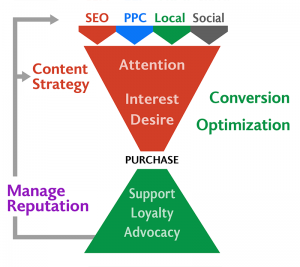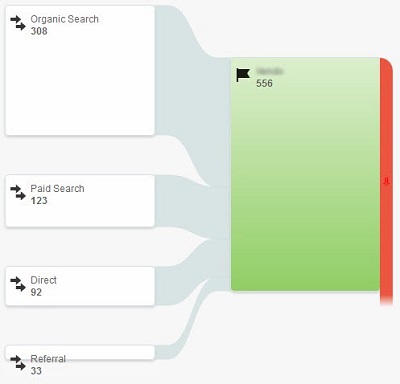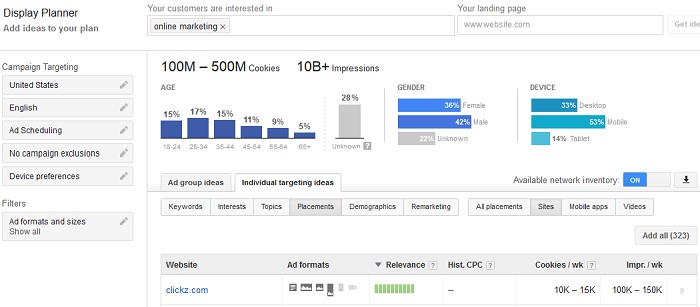 Pour traffic in the top of the marketing funnel and out the other end come qualified prospects and product sales. Sounds simple enough, right? Let’s break it down a bit.
Pour traffic in the top of the marketing funnel and out the other end come qualified prospects and product sales. Sounds simple enough, right? Let’s break it down a bit.
The marketing funnel that I explain here works well for:
- Products and services with a long sales cycle
- Launching products/services that are new to the marketplace
- Products and services that involve research before purchase
- Salesforce supply and ecommerce sales
Start with the end in mind
Unfortunately, getting more traffic to your website doesn’t mean your goal of generating more business is just around the corner. Many of the clients I work with are spending money to get traffic to their sites, usually with Adwords. What do they have in common? Continuing to waste money month after month because most web visitors do not go on to deliver a single business goal.
The traffic trap occurs when a business spends more than it should to get traffic that is mostly unqualified and then fails to adequately follow up on the promising leads they get. They’re trapped – scared to discontinue using Adwords, yet unsure how to improve results or if there are other, better options out there.

Do you know how much money a web visitor is worth? What if you knew that, for every $1 you spent to get traffic to your site, you made $1.25? I’ll bet you could find a few dollars for that.
When you know what a web visitor is worth to your business, then you know how much you should be spending to get that visitor to your website. You also know what is too much to spend. You can learn to calculate how much money a web visitor is worth to your business here: How Much Money Is A Web Visitor Worth?
Then define your goal before you get sucked into the traffic trap and be specific about what you want.
A SMART online marketing goal looks like this:
Increase quality leads from our website by 25% before 12/31
- By optimizing our lead forms and inbound phone call qualifying
- By improving our offer and focusing on traffic sources that bring in sales/good leads
- By assigning tasks to the proper people in the marketing team and call center
- By reviewing progress reports on a regular basis and making adjustments


Step 1: Who is my ideal prospect?
To get a better grasp of your ideal prospect, identify your ideal customer. If you don’t have an ideal customer, it may not be time to do marketing just yet because knowing your ideal customer intimately should be a prerequisite. Marketing works best with clarity and specificity.
You’ll want to identify details about your ideal customer like their fears, desires, responsibilities, challenges, values, motivation to buy and their decision process in selecting your business over competitors. After looking at a good sampling of your customers, patterns begin to emerge that help you identify the basic characteristics of your ideal customer… and prospect. Have coffee with some of them to go a little deeper.
Here’s a sample of one persona my team created for our ideal prospect a few years ago.

Knowing your ideal prospect naturally leads to crafting the offer that s/he cannot easily resist.
Based on the details you uncovered about your ideal customer, you know that s/he has a problem relevant to your business that seems challenging to overcome – like a health problem that doctors have no clear-cut solution for or a business problem like fewer quality leads coming into the business.
When you think about your business in terms of a clearly defined opportunity for those who are feeling pain, it aligns your business with the emotions of your ideal prospect – the first step to attracting your ideal prospect is an enticement to get more details.
- What emotional response do you want prospects and customers to have when they visit your website?
- How can you best communicate with prospects by speaking to their hearts rather than their heads?
For instance, we know that Otis is a skeptical, slow-paced decision maker, so we provide undeniable proof that we have expertise and authority in our industry. One way we do this is by showing him how to solve common problems and then taking him deeper with specific case studies.
Our goal is to foster hope in Otis that he is not alone in his frustration, that we really have the expertise he needs and that he has likely discovered a trustworthy provider who can turn things around. In addition to great content, we use screen shots, photos, faces, video and humor to engage his emotions.
Our enticement depends on the asset we are promoting.
Next, identify the web properties and places where there’s a gathering of your ideal prospects: keywords, social media sites, blogs, forums, answer sites, niche sites, newsletters, magazines, conferences, etc.
Spy on your large, well-known competitors
- SEMRush allows you to see keywords (both SEO and PPC) that competitors are using and much more.
- Follow.net allows you to see keywords (of course), but also social media interaction, ads and links from across the web.
Uncover sites that attract your ideal prospect
- Google Adwords Display Planner – Shows you demographic info, specifics about each recommended website based on keywords or content.
- Mixrank – Helps sales people build lists of prospects and prioritize valuable leads. Basic plan starts at $500/month (last time I checked).
- SimilarWeb – Shows what large competitors are doing: traffic sources, keywords, marketing strategy, ads, apps, audience interests, similar sites, etc.

When you find a site where your ideal prospects hang out, you’ll want to take a few notes:
- Why are they here and what is their real intent for being here?
- Who are the influencers, editors, journalists?
- Why are they using this search term rather than another?
- Which media gets the most engagement here: video, articles, music, images, apps, tools?
For example, in my hunt for Otis the Entrepreneur, I discovered through competitor research that smallbiztrends.com is a resource that a ton of entrepreneurs like Otis visit regularly. Most are there for tips from other entrepreneurs and experts, and for some, their real intent is to solve a current online marketing problem.
Now it makes sense to go a little deeper into smallbiztrends.com by contacting the editor and journalists to get feedback on proposed titles of articles I might send to them. I want to know what type of content Otis consumes and the various ways I can get my message in front of him. (Tip: Use Twitter to get quick feedback from editors and journalists.)
Knowing the answers to these questions will help you massage your enticement so that it gets the attention of those who are regulars in the medium.
You’ve likely seen ads that were clearly out of place due to ignorance of the rules (stated or unwritten) of the community – something that’s glaringly obvious to the regulars. Don’t let that happen to you.
 Todd Brown calls this process marketplace sophistication:
Todd Brown calls this process marketplace sophistication:
You have to understand what claims, promises and messages the marketplace has already heard and been exposed to in order to gauge their marketplace sophistication. Only then can you identify a hook.
A hook or enticement identifies your ideal prospect, clarifies their problem or issue, reveals the solution and makes a big promise that speaks to the heart. Here’s one for Otis:
If you run an ecommerce store and struggle to break even each month, there’s a little-known new marketing strategy that has proven to turn ecommerce stores around in 90 days.
The first step to creating an effective online marketing funnel is knowing your ideal prospect well. Next I’ll cover step two: Create an online asset that clearly demonstrates the power of your solution.

4 replies to "How to Create an Effective Online Marketing Funnel"
Hi Tom,
Great article, I would add 1 thing and it’s about showing relevant landing pages to different people depending on where in the funnel they are, either by using marketing automation software or by their search terms.
Yes, excellent point Simon. I’ll cover some of that in my next post but I like what you said about marketing automation software. Do you recommend one?
I am new for creating online reputation management (ORM), and your perspective is sounds interesting how i wish this strategy will thrive your business… Thanks Tom, for the share!
Thanks Doris. The marketing funnel I outlined above is the “thrive” starting point for most businesses who have a long sales cycle.